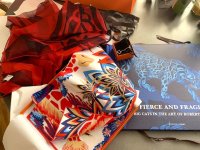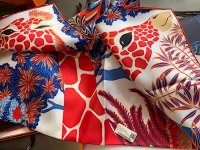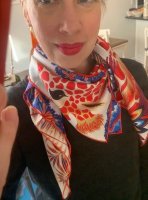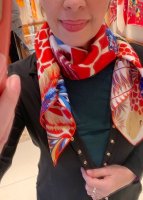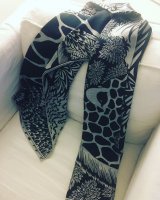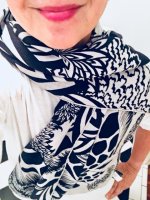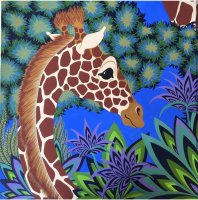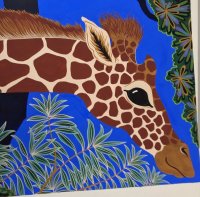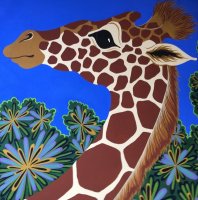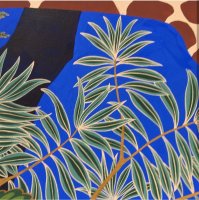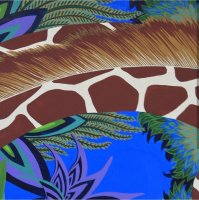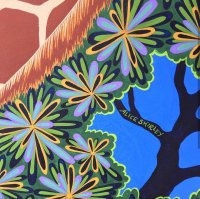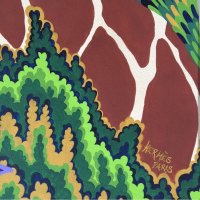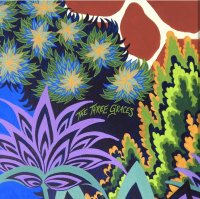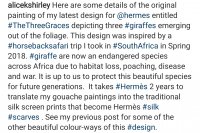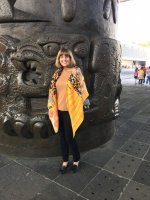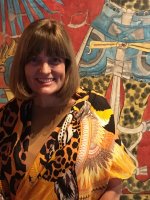Just came across this video for the Royal Drawing School but it showcases her work for Hermes.
You are using an out of date browser. It may not display this or other websites correctly.
You should upgrade or use an alternative browser.
You should upgrade or use an alternative browser.
Scarves Alice Shirley Fan Club
- Thread starter MissIn
- Start date
TPF may earn a commission from merchant affiliate
links, including eBay, Amazon, and others
More options
Who Replied?Adding in my Three Graces purchase from my boutique visit here... this is very different from anything else I have! (But doesn't feel too R/W/B flag waving because of the gold and black in it...)
H003441S 05 blanc/rouge/bleu
View attachment 4633427
View attachment 4633428
View attachment 4633429
At the boutique:
View attachment 4633430
Oh wow, this is so pretty! Love the colours. I’ll be on the lookout for this one!
Oh wow, this is so pretty! Love the colours. I’ll be on the lookout for this one!
Thank you lolakitten! This one is really pretty!
I've never seen the yellow JQ ... so beautiful on you, Ladybaga!View attachment 4647469 View attachment 4647470 Hello Friends!
I just wanted to post my on site Alice Shirley JQ 140 shawl. I went to Mexico City this fall and had this photo taken at the Anthropology Museum. It was so fascinating!
Thank you, dear Croisette! It has become one of my most worn scarves.I've never seen the yellow JQ ... so beautiful on you, Ladybaga!
Gorgeous and what a wonderful trip to make! Love the shawl on site!View attachment 4647469 View attachment 4647470 Hello Friends!
I just wanted to post my on site Alice Shirley JQ 140 shawl. I went to Mexico City this fall and had this photo taken at the Anthropology Museum. It was so fascinating!
Thank you, Lanit! It was so much fun and would love to go back for longer than a weekend.Gorgeous and what a wonderful trip to make! Love the shawl on site!
Wild Singapore, her latest design in 90cm silk.
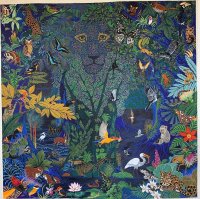
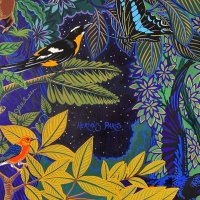
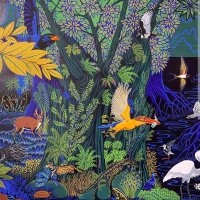
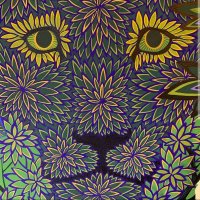
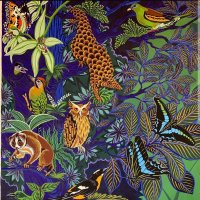
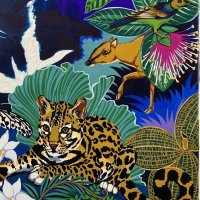
"Here is the original painting for my new #silk #carre design for Hermes A/W 2020 entitled #WildSingapore This is a design that celebrates the wondrous biodiversity of Singapore, exploring its two main habitats: rainforest (left side of the composition and mangrove forest (right side of the composition). I have tried to include species from as many animal and plant groups as I could in the design. The setting is at night because many creatures in Singapore are nocturnal species.
There are green cloudy forms on the horizon that could be more jungle, or could suggest clouds, reminding us that Singapore is an island, surrounded by sea, but the mainland is not far at all. The rainforest habitat is rich with native species, and the mangrove habitat has many visitor species, as well as resident species. Singapore is on the great Eastern migration path, for birds migrating from northern Asia down towards Australia. Singapore is an important place for these birds to feed and rest on their huge journey. The #SungeiBuloh wetland reserve is a vital habitat for these birds. Singapore’s urban spaces are filled with greenery and parks such as the beautiful Botanic Gardens, to encourage wildlife, and it is important to plant native species in urban areas to help native wildlife and provide ‘green corridors’ through the city.
The huge strangler fig tree in the centre of the design, hosting a wealth of epiphytic plants such as climbers, ferns, palms and orchids, has the shape of a lion hidden in its foliage. The lion is the national symbol of Singapore (Lion City), not because the jungle used be the home of lions, but because a Malayan prince was shipwrecked on the island, and claimed he saw a lion. This is not possible, no native species of lion has ever lived on a Singapore, but tigers once roamed freely until the last one was shot in 1930. Perhaps he saw a tiger, and thought it was a lion. He decided to found a city there and named it Singapore, ‘Lion City’. The benevolent spirit of the forest is lion-formed, a very human construct, that cares for the plants and animals. This design reminds us of nature’s beauty, and complexity, it is a delicate balance of species." (from Alice Shirley's Instagram)






"Here is the original painting for my new #silk #carre design for Hermes A/W 2020 entitled #WildSingapore This is a design that celebrates the wondrous biodiversity of Singapore, exploring its two main habitats: rainforest (left side of the composition and mangrove forest (right side of the composition). I have tried to include species from as many animal and plant groups as I could in the design. The setting is at night because many creatures in Singapore are nocturnal species.
There are green cloudy forms on the horizon that could be more jungle, or could suggest clouds, reminding us that Singapore is an island, surrounded by sea, but the mainland is not far at all. The rainforest habitat is rich with native species, and the mangrove habitat has many visitor species, as well as resident species. Singapore is on the great Eastern migration path, for birds migrating from northern Asia down towards Australia. Singapore is an important place for these birds to feed and rest on their huge journey. The #SungeiBuloh wetland reserve is a vital habitat for these birds. Singapore’s urban spaces are filled with greenery and parks such as the beautiful Botanic Gardens, to encourage wildlife, and it is important to plant native species in urban areas to help native wildlife and provide ‘green corridors’ through the city.
The huge strangler fig tree in the centre of the design, hosting a wealth of epiphytic plants such as climbers, ferns, palms and orchids, has the shape of a lion hidden in its foliage. The lion is the national symbol of Singapore (Lion City), not because the jungle used be the home of lions, but because a Malayan prince was shipwrecked on the island, and claimed he saw a lion. This is not possible, no native species of lion has ever lived on a Singapore, but tigers once roamed freely until the last one was shot in 1930. Perhaps he saw a tiger, and thought it was a lion. He decided to found a city there and named it Singapore, ‘Lion City’. The benevolent spirit of the forest is lion-formed, a very human construct, that cares for the plants and animals. This design reminds us of nature’s beauty, and complexity, it is a delicate balance of species." (from Alice Shirley's Instagram)
This is spectacular! Hope to find her scarf in this colorway, soon!!!Wild Singapore, her latest design in 90cm silk.
View attachment 4803194View attachment 4803195View attachment 4803190View attachment 4803191View attachment 4803192View attachment 4803193
"Here is the original painting for my new #silk #carre design for Hermes A/W 2020 entitled #WildSingapore This is a design that celebrates the wondrous biodiversity of Singapore, exploring its two main habitats: rainforest (left side of the composition and mangrove forest (right side of the composition). I have tried to include species from as many animal and plant groups as I could in the design. The setting is at night because many creatures in Singapore are nocturnal species.
There are green cloudy forms on the horizon that could be more jungle, or could suggest clouds, reminding us that Singapore is an island, surrounded by sea, but the mainland is not far at all. The rainforest habitat is rich with native species, and the mangrove habitat has many visitor species, as well as resident species. Singapore is on the great Eastern migration path, for birds migrating from northern Asia down towards Australia. Singapore is an important place for these birds to feed and rest on their huge journey. The #SungeiBuloh wetland reserve is a vital habitat for these birds. Singapore’s urban spaces are filled with greenery and parks such as the beautiful Botanic Gardens, to encourage wildlife, and it is important to plant native species in urban areas to help native wildlife and provide ‘green corridors’ through the city.
The huge strangler fig tree in the centre of the design, hosting a wealth of epiphytic plants such as climbers, ferns, palms and orchids, has the shape of a lion hidden in its foliage. The lion is the national symbol of Singapore (Lion City), not because the jungle used be the home of lions, but because a Malayan prince was shipwrecked on the island, and claimed he saw a lion. This is not possible, no native species of lion has ever lived on a Singapore, but tigers once roamed freely until the last one was shot in 1930. Perhaps he saw a tiger, and thought it was a lion. He decided to found a city there and named it Singapore, ‘Lion City’. The benevolent spirit of the forest is lion-formed, a very human construct, that cares for the plants and animals. This design reminds us of nature’s beauty, and complexity, it is a delicate balance of species." (from Alice Shirley's Instagram)
Indeed!This is spectacular! Hope to find her scarf in this colorway, soon!!!

Just discovered that there will be limited edition watches of the Into the Canadian Wild:
Arceau Into the Canadian Wild
A miniature painting on aventurine adorns the Arceau watch, like an anthem to the luxuriant Nature abounding in Canada.
The round case with its asymmetrical stirrup shaped lugs is the hallmark of the timeless allure exuded by the Arceau watch, designed by Henri d’Origny in 1978. Available in two limited series of 24 each, the Arceau Into the Canadian Wild watch in white gold and diamonds captures the spirit of wild Nature on its dial.


© Hermès
The animal themes interpreted here – a polar bear and a snowy owl – both stem from the Into the Canadian Wild silk scarf designed by British artist Alice Shirley in 2017, on the occasion of Canada’s 150th anniversary. The original drawing depicts the abundance of flora and fauna, natural treasures of Canada’s vast territories bathed in oceans, lakes and rivers. From this hymn to nature, Hermès Horloger has drawn two interpretations: a snowy owl – emblematic of Quebec – flying amid the Northern Lights (aurora borealis) graces the first model; while the other features a polar bear with its cub, standing on top of waves populated by fascinating creatures.
The artisan devotes more than a week per dial to accomplishing this miniature work, tracing the contours of the motif on the glittering aventurine base, before placing it in the kiln to fire it in place. The different volumes of the landscapes and animals are then formed by means of successive layers of paint alternating with successive firings. The major requirement of such a work lies in the miniaturisation of a drawing with multiple volumes, tones and subtle details.

Combining watchmaking and craftsmanship, the Arceau Into the Canadian Wild watch is powered by a mechanical self-winding Hermès movement. It displays hours and minutes on the model adorned with a polar bear, along with a moon phase on the model featuring the snowy owl. An elegant white gold case set with 82 diamonds frames the hand-crafted dial and is complemented by a smooth sapphire blue alligator strap, also made by the Hermès Horloger artisans.
Arceau Into the Canadian Wild
A miniature painting on aventurine adorns the Arceau watch, like an anthem to the luxuriant Nature abounding in Canada.
The round case with its asymmetrical stirrup shaped lugs is the hallmark of the timeless allure exuded by the Arceau watch, designed by Henri d’Origny in 1978. Available in two limited series of 24 each, the Arceau Into the Canadian Wild watch in white gold and diamonds captures the spirit of wild Nature on its dial.


© Hermès
The animal themes interpreted here – a polar bear and a snowy owl – both stem from the Into the Canadian Wild silk scarf designed by British artist Alice Shirley in 2017, on the occasion of Canada’s 150th anniversary. The original drawing depicts the abundance of flora and fauna, natural treasures of Canada’s vast territories bathed in oceans, lakes and rivers. From this hymn to nature, Hermès Horloger has drawn two interpretations: a snowy owl – emblematic of Quebec – flying amid the Northern Lights (aurora borealis) graces the first model; while the other features a polar bear with its cub, standing on top of waves populated by fascinating creatures.
The artisan devotes more than a week per dial to accomplishing this miniature work, tracing the contours of the motif on the glittering aventurine base, before placing it in the kiln to fire it in place. The different volumes of the landscapes and animals are then formed by means of successive layers of paint alternating with successive firings. The major requirement of such a work lies in the miniaturisation of a drawing with multiple volumes, tones and subtle details.

Combining watchmaking and craftsmanship, the Arceau Into the Canadian Wild watch is powered by a mechanical self-winding Hermès movement. It displays hours and minutes on the model adorned with a polar bear, along with a moon phase on the model featuring the snowy owl. An elegant white gold case set with 82 diamonds frames the hand-crafted dial and is complemented by a smooth sapphire blue alligator strap, also made by the Hermès Horloger artisans.
© Hermès
Register on TPF! This sidebar then disappears and there are less ads!

